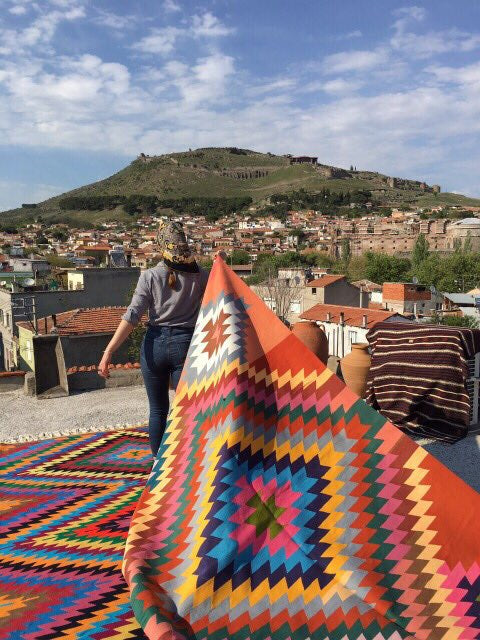
This breathtaking image captures a powerful blend of cultural heritage and craftsmanship. In the foreground, we see a stunning display of handmade Turkish rugs, rich in color and pattern, lying gracefully on stone pavement. Each rug is a piece of art — woven with intricate geometric and symbolic motifs in deep reds, warm oranges, earthy browns, and vivid accents. They reflect centuries of tradition, passed down through generations of skilled artisans.
Behind them, ancient ruins — Red Basilica — rise dramatically against a brilliant blue sky. The play of sunlight filtering through the crumbling walls evokes a sense of timelessness. This setting beautifully marries the old with the older: architecture shaped by civilizations and carpets shaped by human hands and heritage
Handmade Turkish rugs are far more than just decorative pieces. They carry deep cultural, functional, and emotional value:
-
Cultural Storytelling: Every rug tells a story — of the weaver’s village, traditions, beliefs, and even personal experiences. Symbols in the patterns often represent fertility, protection, and blessings.
-
Sustainability and Craftsmanship: Made with natural materials like wool, cotton, and vegetable dyes, these rugs are environmentally friendly and built to last. Their durability makes them practical for everyday use — unlike mass-produced, synthetic alternatives.
-
Warmth and Comfort: In many Turkish homes, rugs are used to cover floors, walls, and even tables. They bring warmth in winter and serve as cozy gathering places for family life, meals, and storytelling.
-
Economic and Social Impact: Rug weaving supports rural communities, especially women, preserving age-old techniques and sustaining local economies.
-
Spiritual and Symbolic Use: Rugs are often used in prayer and religious rituals. Their placement in homes can also reflect hospitality, honor, and respect for guests.


0 comments